The warm, gin-clear waters of the Maldives boast some of the best diving sites in the world. Like scattered pearls across the Indian Ocean, the tropical islands of this archipelagic nation are surrounded by coral reefs, sandy banks, and steep drop-offs that some of the planet’s most breathtaking marine life call home.
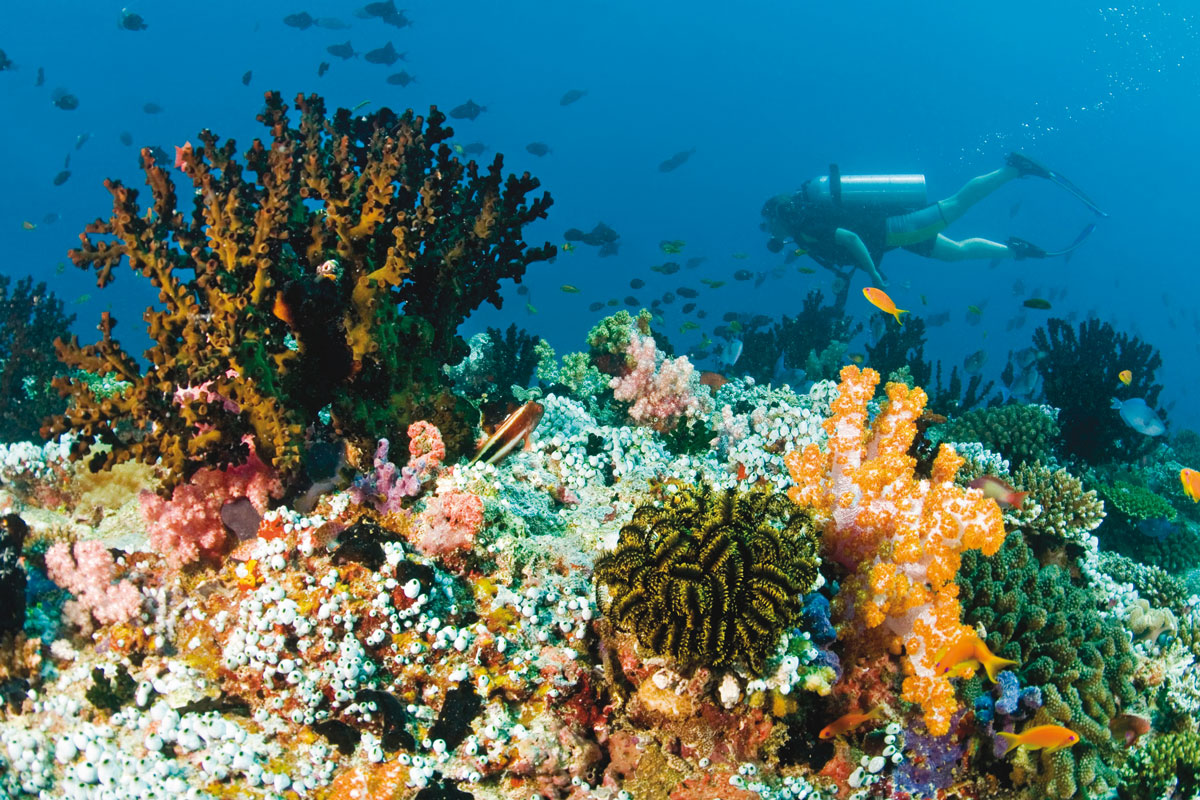
Best Time to Go
The Maldives has a year-round hot tropical climate with two monsoon seasons – the dry season associated with the northeastern winter monsoon, which lasts from November to April, and the rainy southwest monsoon season which lasts from May to October and brings strong winds and storms. The monsoonal influence is more significant in the north than in the south, which is more influenced by the equatorial currents.
The annual rainfall averages 100 inches in the north and 150 inches in the south, and even during the monsoon seasons, the air temperature rarely falls below 25°C (77°F). The water temperature is the Maldives is around 28-29°C (82 – 84°F) degrees in the atolls and 30-32°C (86 – 88°F) inside the island’s lagoons.
The best time to visit the Maldives for scuba diving is during February, March, and April, which boast long sunny days, flat seas and higher chances to dive with the magnificent manta rays and gentle whale sharks.
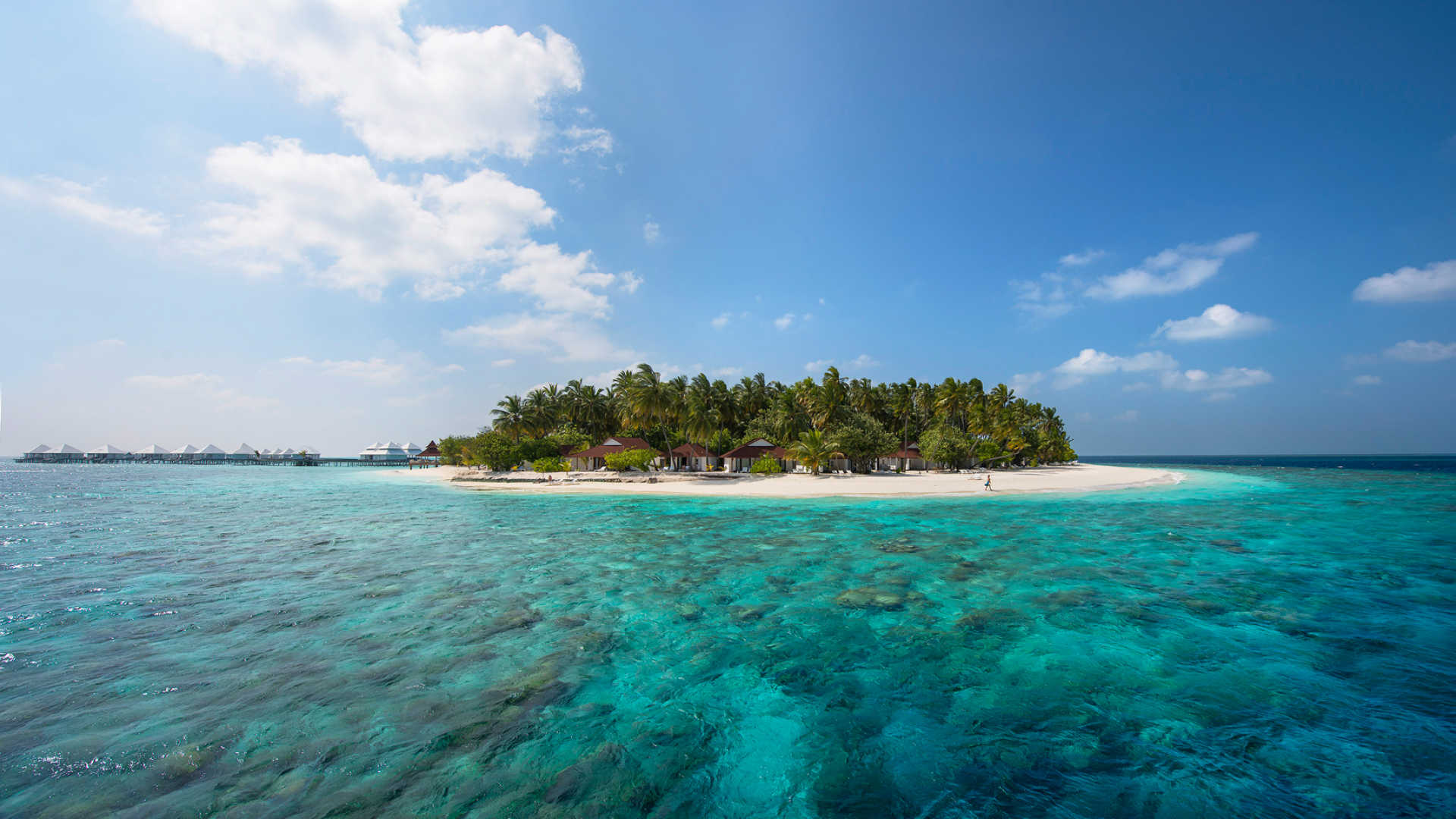
Getting Around
The Maldives is made up of 1,190 islands spread across 26 atolls, which are situated in the precious Laccadive Sea, a few hundred miles south-west of Sri Lanka and India. Visitors generally enter the country by air, landing at the Velana International Airport, which is on the island of Hulhulé, near the capital Malé, and move onwards from there. However, there are a few smaller airports in the larger atolls that are also served by international flight companies such as the Gan Airport, on the southern atoll of Addu.
There are only two ways to move around the myriad of tiny islands that make up the Maldives, namely by boat or by seaplane. Connections or transfers by boat from the airports to the resorts are done either with the traditional Maldivian boats called dhonis or more modern and faster speedboats, while seaplane connections are used for longer journeys to resorts further away and provide a fascinating way to move around the atolls with spectacular aerial views.
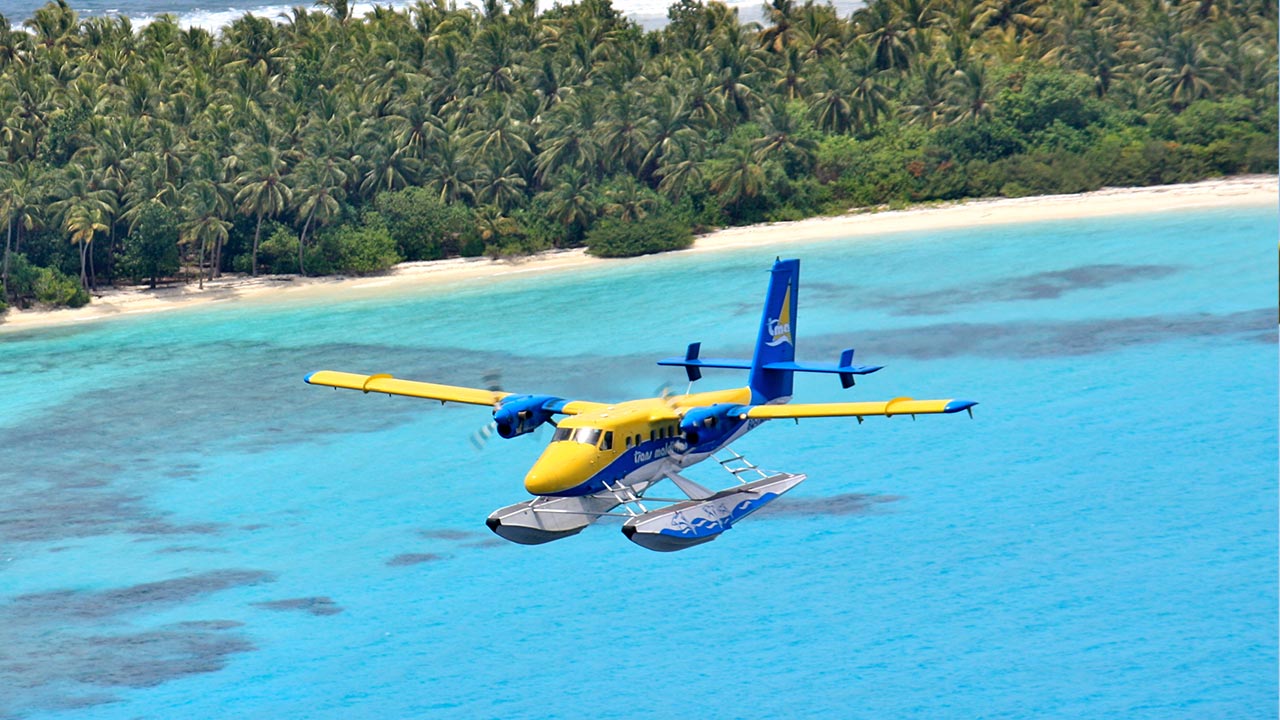 Photo credit: Transmaldivian Airlines
Photo credit: Transmaldivian Airlines
Where to Stay
The Maldives offers two types of accommodation when it comes to a scuba diving holiday – a resort with spectacular house reef and charter boat diving, or an all-inclusive liveaboard boat – both of which provide different kinds of holidays, but just as fantastic experiences.
House Reef Diving
The Maldives have around 2,500 reefs, of which about 900 are house reefs. A house reef is defined as being a reef that is close to or surrounding an island resort and one that offers excellent snorkeling or scuba diving opportunities. More often than not, house reefs can be explored by simply entering the water from the beach, rather than a boat, making them ideal for snorkelers and less experienced divers. Most of the island resorts have dive centers with qualified dive instructors to lead guests on dives and show them the best parts of the reef and its amazing inhabitants.
Some of the best house reefs in the Maldives include Baros Maldives (a 2.5-mile house reef); Mirihi Island Resort (a 3.7-mile house reef); Lily Beach Resort (a 1.8-mile house reef); Reethi Beach Resort (a 1.8-mile house reef); Bathala Island Resort (a 1-mile house reef); and Diamonds Athuruga (a 2.7-mile house reef). Click here to book any of these amazing resorts.
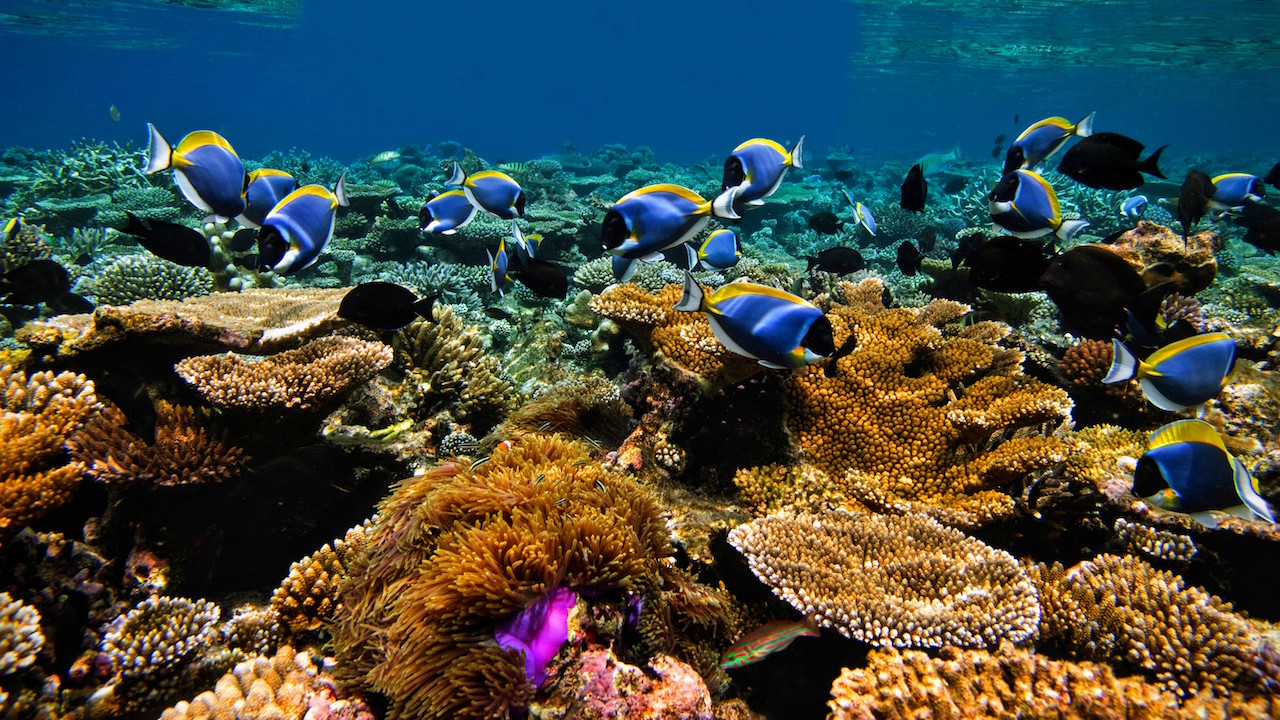 Photo credit: Jumerieh Dhevanafushi House Reef
Photo credit: Jumerieh Dhevanafushi House Reef
Liveaboard Scuba-Diving
Another option for a scuba diving holiday is to spend a week on a liveaboard, which provides the opportunity to explore different atolls and experience a variety of dive sites without being anchored in one place. Liveaboard trips are all-inclusive, which includes comfortable accommodation, all meals, and several dives a day with qualified dive instructors, including night dives, ensuring all you have to think about it eat, sleep, dive, repeat.
Liveaboard cruises usually last for seven nights, however, longer cruises are available at specific times of the year, allowing for more time to travel and explore an extensive area and less frequented dive sites.
There are various options of liveaboards, depending on your budget and taste. The Emperor Maldives fleet has six boats, ranging from the luxurious MV Emperor Serenity to the more basic MV Emperor Atoll. The MV Ari Queen and MV Stingray are ideal if you are on a budget, but still want the home comforts like an en-suite shower, while the Nautilus II offers peaceful sailing cruises. For those in search of absolute luxury, Blue Force One offers spacious cabins with a Jacuzzi in the master suite.
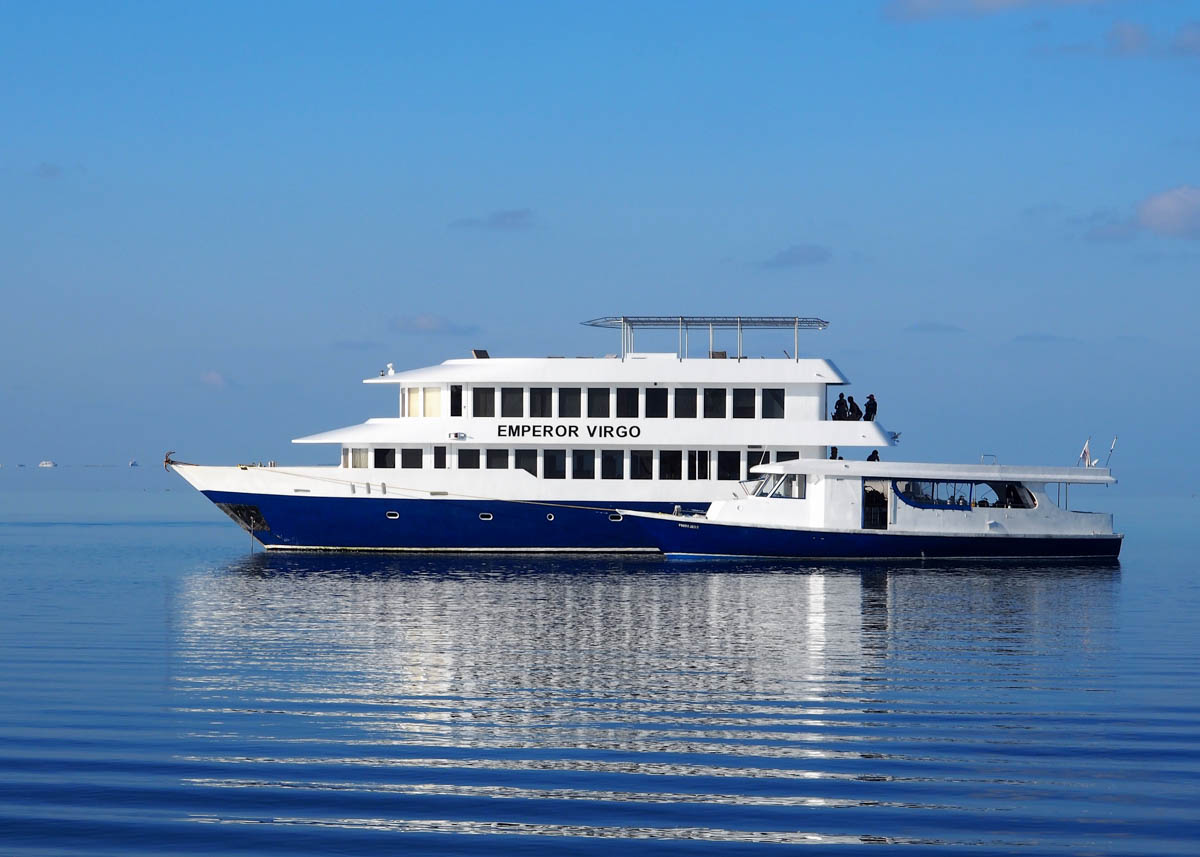 Photo credit: Emperor Maldives
Photo credit: Emperor Maldives
Scuba Diving in the Maldives
The spectacular natural beauty of the Maldives’ palm-fringed tropical islands continues beneath the surface of the ocean with pristine reefs teeming with vibrant corals, brightly colored fish, and a myriad of other marine life, making it one of the best places in the world for scuba diving.
Home to 26 atolls, which span over 500 nautical miles from Haa Alifu in the North to the Addu Atoll in the South, the Maldives packs a punch when it comes to idyllic islands, however, the amount of land that lies above sea level in the Maldives represents only a tiny fraction of the country’s overall land mass, most of which lies below sea level. The nearly 1,200 islands of the Maldives are just the visible coral tips of an extensive oceanic volcanic mountain range whose outer edges can sometimes plunge to depths of almost 10,000 feet.
The relative isolation of the Maldives in the Indian Ocean has led to an extraordinary and diverse variety of marine species that call it home. Strong seasonal oceanic currents flowing through the country’s many islands have forged deep channels from the open ocean into the atolls. These channels direct plankton-rich waters into and out of the atolls, which in turn support an incredibly vibrant marine ecosystem. Inside the atoll, reefs, sandbars, islands, and lagoons have evolved over millennia to create nurseries and habitats for many of the reef’s inhabitants.
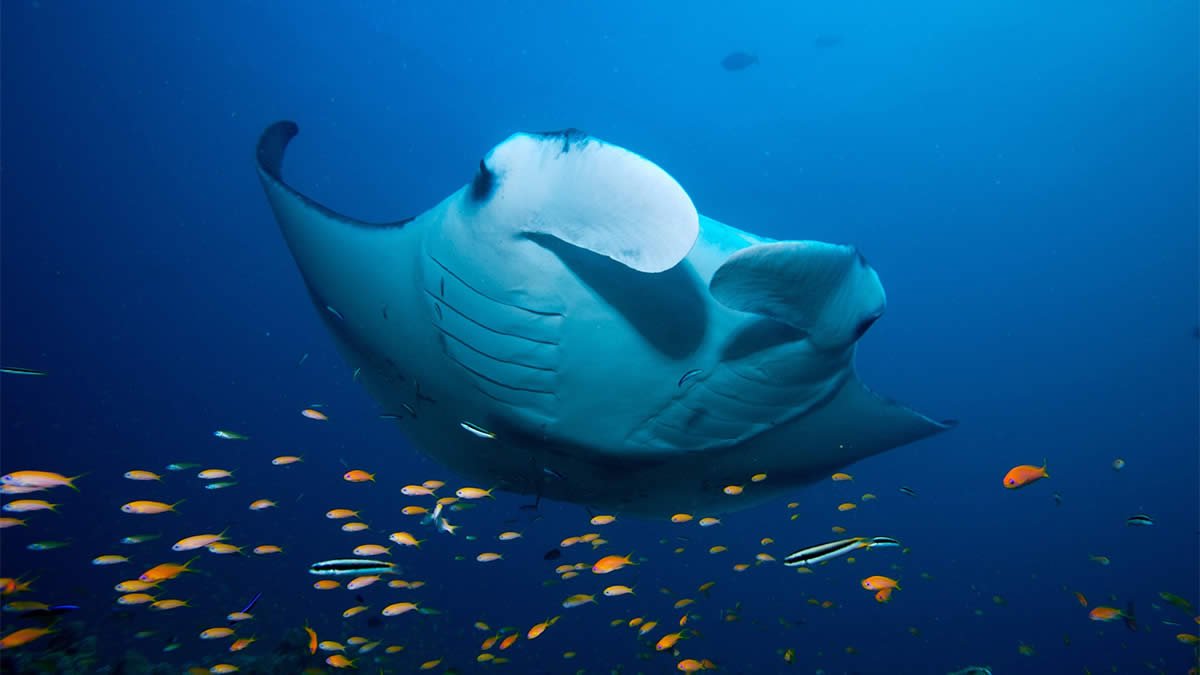 Photo credit: ProDivers
Photo credit: ProDivers
Diving Conditions
Scuba diving in the Maldives is characterized by strong currents, which range from modest to intensive, depending on the location, the period of the month and the hour of the day.
Underwater Landscapes & Typologies
In the Maldives, there are three main typologies of diving sites – Thilas/Giris (underwater pinnacles), Kandus (channels that connect the inner atolls to the open ocean; and Farus (corals and reefs that surround the atolls).
Thilas or Giris (Pinnacles)
Thilas or Giris are submerged pinnacles that can vary in size, are usually covered with hard and soft corals and are home to a rich variety of reef marine life. Thilas are more substantial than Giris with a submerged edge of between 50 and 100 feet, while Giris tend to be more superficial with submerged margins of between 16 and 65 feet. Thilas situated on the inside of the atoll are usually quiet and current-free and are home to a variety of shy marine life such as the leaf fish, the frog fish, nudibranchs, and other small aquatic life. Thilas that lie within a Kandu are surrounded by stronger currents, but also offer fascinating sea life and underwater action with grey reef sharks, eagle rays, barracudas and snappers swimming in the current.
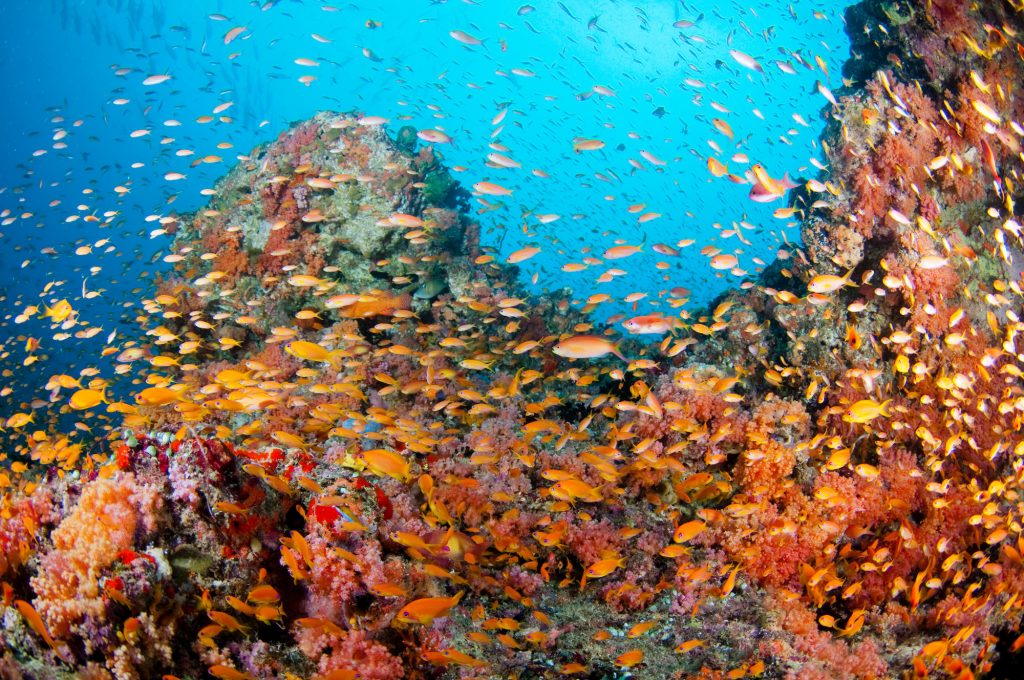 Photo credit: ZuBlu Diving
Photo credit: ZuBlu Diving
Kandus (Channels)
Kandus are the channels that connect the lagoons with the ocean. Created by oceanic currents eroding the edges of the atolls, these channels are rich with ocean-going nutrients, attracting many of the larger pelagics such as grey reef sharks, tuna and manta rays who come to feed, and provide fantastic drift diving experiences.
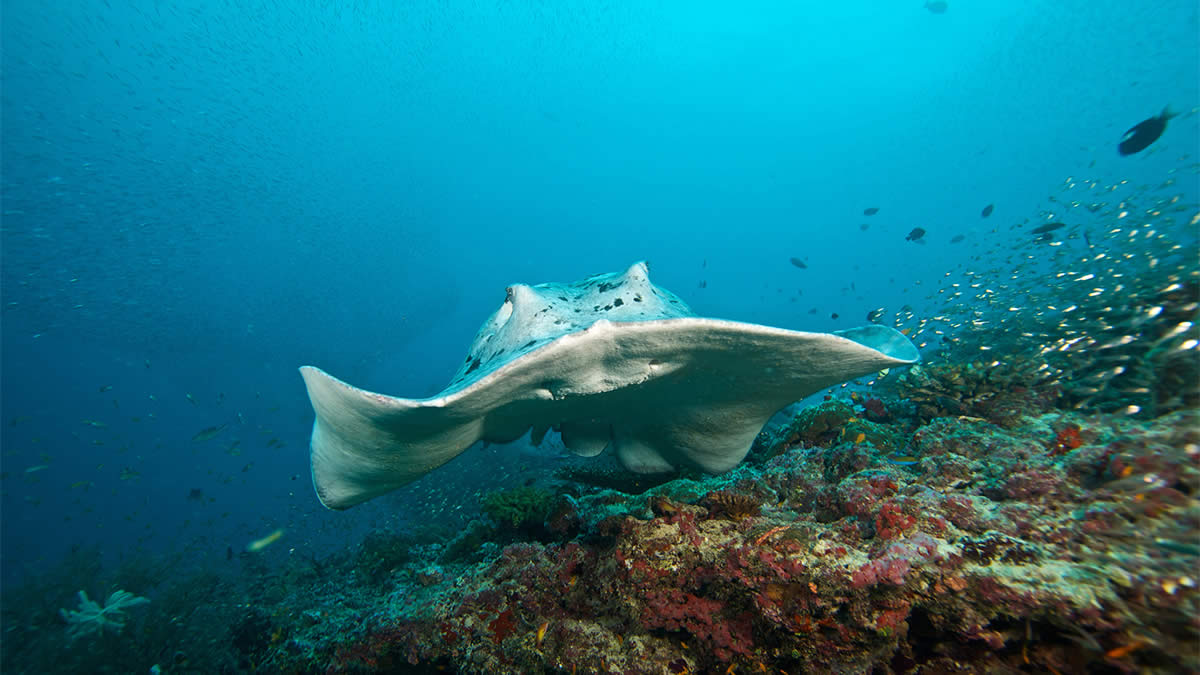 Photo credit: ProDivers
Photo credit: ProDivers
Farus
Farus are small formations of corals and reefs that surround the atolls and offer excellent diving opportunities, regardless of the season and the direction of the currents. Farus tend to attract a wide variety of fish and pelagics, such as sharks, turtles, all kind of rays, and trigger fish.
Best Diving Sites
Home to 1,190 islands spread across 26 atolls and around 2,500 reefs, the Maldives offers a myriad of magical scuba diving experiences from Haa Alifu in the North to the Addu Atoll in the South. Ari Atoll features some of the country’s best dive sites, which are easy to reach and boast both pelagic fish and colorful reefs, while the South Malé Atoll features a plethora of dive sites with caves, wrecks, and wicked drifts. Here are some of the Maldives top diving sites:
Ari Atoll
The Ari Atoll is considered a pelagic haven with thilas (pinnacles) and kandus (channels) that are exposed to the open ocean currents and attract a variety of giant marine creatures such as graceful whale sharks, feeding manta rays, and schooling hammerheads. Due to the exposed nature of the atoll, currents in and around the Ari Atoll can be robust, and many dive sites might not be suitable for beginners.
Top dive sites in the Ari Atoll include Maaya Thila and Fish Head. Widely regarded as one of the top dive sites in the Maldives, Maaya Thila boasts a pinnacle that begins at 20 feet and drops gently to 40 feet. The shallows feature nudibranchs, frog fish and zebra morays, while further down divers will delight in flying formations of eagle rays, schools of colorful fish, and the occasional guitar shark. Maaya Thila has variable currents and can be suitable for beginners.
Located in the mid-eastern region of the atoll, Fish Head is a dive site located within a protected marine area and one of the best places in Ari Atoll for spotting sharks. A pinnacle plunges from 32 to 115 feet is dotted with caves and overhangs, which attract grey reef sharks and thousands of blue line snappers. Due to the depth of the underwater spire and unpredictable currents, this dive is best suited for intermediate and advanced divers.
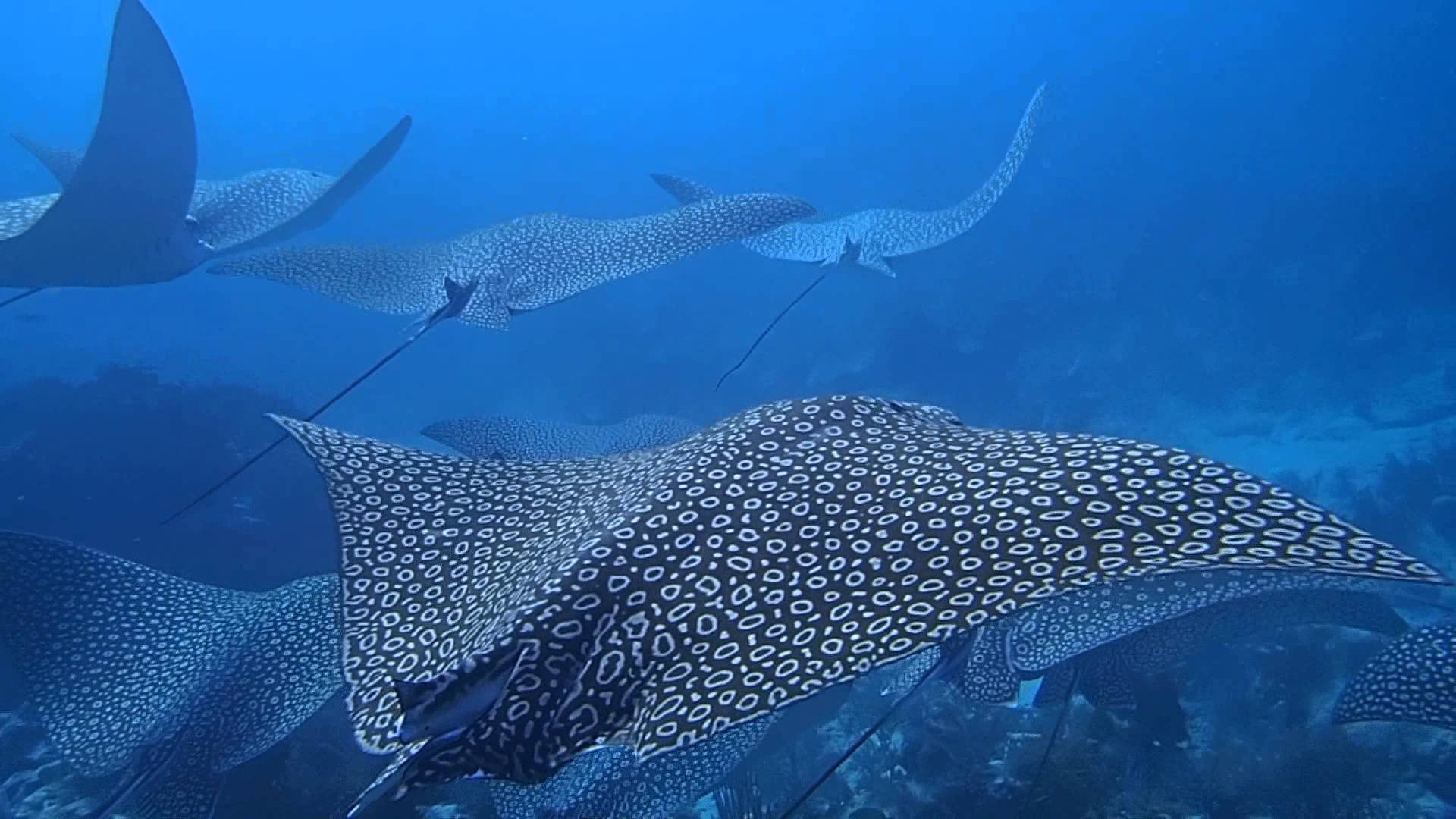 Photo credit: iDive
Photo credit: iDive
Baa Atoll
Baa Atoll was awarded UNESCO Reserve status in 2011 and features brightly colored reefs, overhangs, and big pelagics such as manta rays and whale sharks. Top dive sites in the Baa Atoll include the Horubadhoo Thila, Nelivaru Haa, and Dhonfanu Thila.
Part of the atoll’s protected reef, the Horubadhoo Thila rests at a depth of between 39 and 52 feet and is covered in hard and soft corals and plenty of macro marine life, including schools of blackjacks, glassy fish, and fusiliers. Manta rays use the Thila as a cleaning station during the south-west monsoon from May through November.
Nelivaru Haa lies to the south-east of the atoll and boasts a unique topography of star-shaped canyons, overhangs covered hard and soft corals, and caves filled with schools of shy oriental sweet lips, big groupers, and moray eels. Other marine life along the reef’s walls include friendly batfish, curious stingrays, and manta rays, which use the site as a cleaning station during certain times of the year.
Dhonfanu Thila is an incredible site for advanced divers to explore with a narrow swim-through lined with black coral that begins at 82 feet and ascends to 59 feet. Overhangs are home to yellow-lined snapper, soldier fish and cleaning wrasses, along with black pyramid butterfly fish, red-toothed triggers, parrot fish, angelfish and starry rabbit fish.
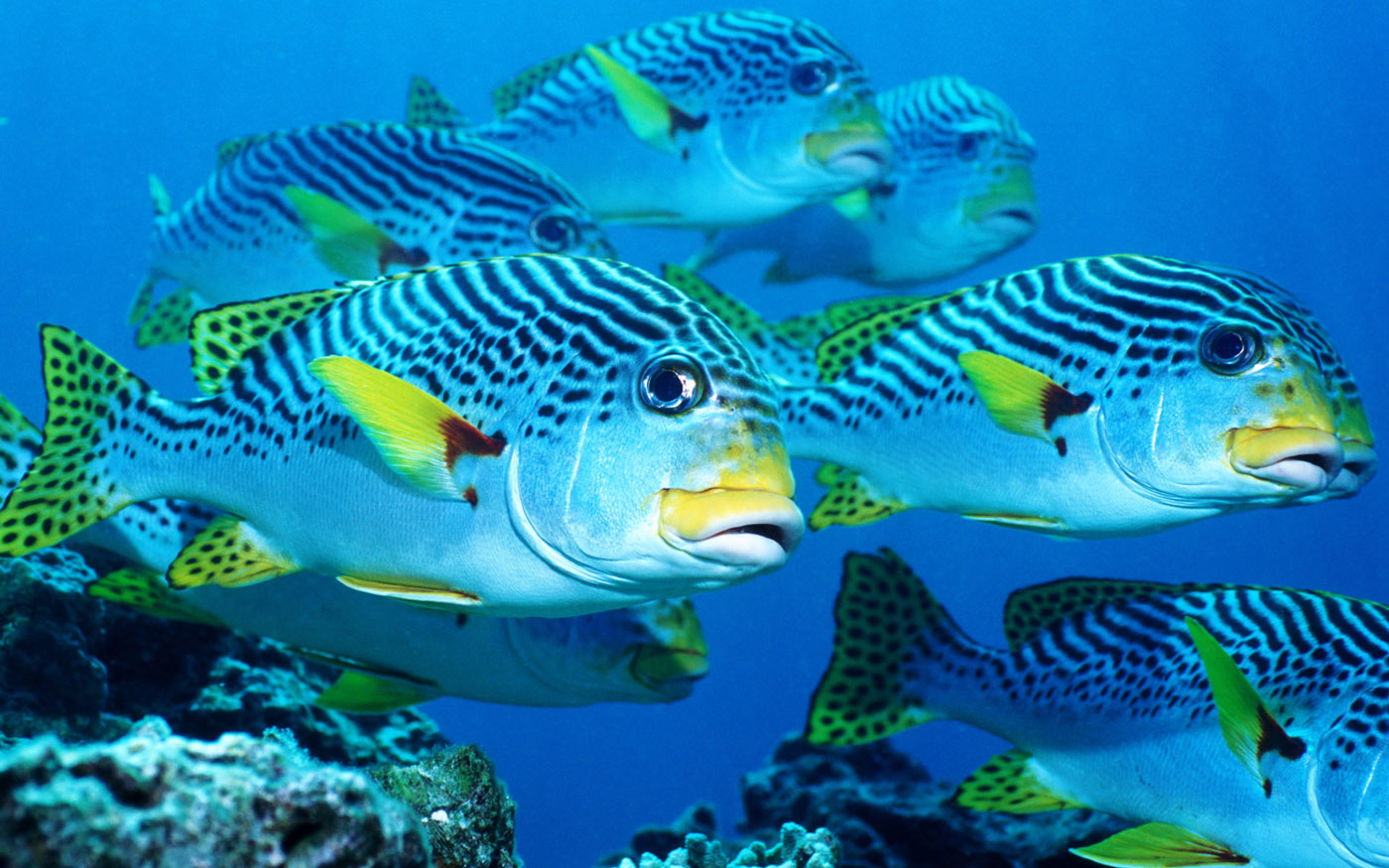 Photo credit: OceanDimensions
Photo credit: OceanDimensions
North Malé Atoll
With easy access from Malé and home to some of the best diving sites in the country, the North Malé Atoll features deep wrecks, colorful coral reefs, and colossal feeding manta rays. One of the most visited regions in the Maldives, the North Malé Atoll is a diving wonderland with several one-of-a-kind underwater experiences.
The Okobe Thila features three towering pinnacles ranging from 30 to 165 feet in length with spiraling currents that attract massive tuna, white-tip reef sharks, and friendly bannerfish. The submerged spires are covered with brightly colored hard and soft corals that make for excellent photographic opportunities.
The Maldives Victory Wreck is a 328-foot-long Singaporean cargo ship which ran aground in 1981 and rests at between 39 and 115 feet below sea level. One of the Maldives’ top diving sites, the wreck is encrusted in corals and fans and is home to a myriad of bat fish, fusiliers, and grouper, and as well as the occasional turtle.
The best place in the North Malé Atoll for spotting manta rays is Manta Point, which is located in the southeast of the atoll. A vibrant coral reef begins at 39 feet below the surface, and as it descends, it attracts larger fish, from barracudas and hawksbill turtles to massive napoleon fish and manta rays. Between May and October, the manta rays can be seen in their rare cyclone feeding formation.
Other top diving sites in the Maldives include the Faafu Atoll, which features unspoiled reefs, stimulating channel dives, two wrecks on a resort’s house reef, and frequent manta sightings; the Dhaalu Atoll with its broad channels, deep caves, stunning drop-offs, and plenty of marine life; and the unique and unchartered Fuvahmulah Atoll, that promises pristine reefs, oceanic mantas and rare sharks like the thresher, tiger, and oceanic white tip.
Article by Mia Russell ©



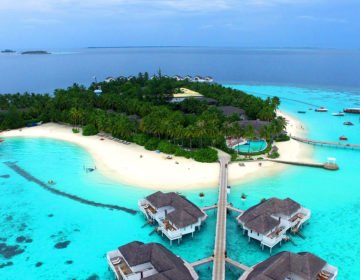
[…] There are also a number of liveaboard diving boats which offer night dives as part of the vacation package. Check out this article for more information on scuba diving in the Maldives. […]
[…] sandbanks, the Maldives offer a wealth of activities for all tastes, ranging from snorkeling and scuba-diving to swimming, surfing, and sun-worshipping, which can be enjoyed […]
[…] PADI Gold Palm and certified Dive Centre is complete with nitrox, re-breathers, underwater scooters and more, and offers a selection of […]
[…] for the incredible density of marine life that can be found on the resort’s house reef and offers scuba diving and snorkeling experiences second to none. The resort is not only home to a pristine house reef, which can be […]
[…] side of Kassan Faru Kandu is a channel dive with a steep reef between one and 30 meters. The best diving is between 10 and 20 meters near the corner where there is a large rock rising to three meters. The […]
[…] is a channel dive on the southeast point of Thunba Falhu with a steep drop-off from three to 25 meters, then sloping […]
[…] and those just below the surface are clearly defined by sharp contrasts in watercolor. Most of the diving in North Malé Atoll is in the channels, or kandus, through the outer barrier reef of the atoll. There are around 20 […]
[…] and learning how to cook traditional Maldivian cuisine. Sports and recreational activities include snorkeling and scuba diving, free-diving, paddle-boarding, surfing, parasailing, jet skiing and sunset […]
[…] these small plants and animals, and are one of the top attractions in the Maldives, attracting snorkelers and divers from around the world to see and experience swimming with them in the […]
[…] Divers should be aware that powerful currents occur in Makunudhoo Kandu and can be dangerous, especially outgoing ones. Divers can see most of the features of the reef if they limit their depth to 25 meters to maximize bottom time before ascending to make an open water safety stop. A safety balloon should always be carried here. […]
[…] are many ways to dive this channel depending on the current. If the current is not too strong, divers can venture across […]
[…] place on earth. Many tourists travel to the Maldives for snorkeling and underwater adventures. Scuba diving in the Maldives is one of the most appreciated water sport here. Divers and snorkelers from all over the world come […]
[…] you’re going to move around several different islands and have dive sites all to yourself, a safari cruise might be the best way to go. The number of companies offering safari trips has increased […]
[…] can be strong and the seas turbulent here as there is little protection. Divers may have to begin their dive up-current from the thila and drift quickly down to the protection of […]
Nice. This blog is very perfect and usefully information.
Many thanks!
hi,
is there any diving position available?
may i have your Email. for send my CV letter
[…] sandbanks, the Maldives offer a wealth of activities for all tastes, ranging from snorkeling and scuba-diving to swimming, surfing, and sun-worshipping, which can be enjoyed […]